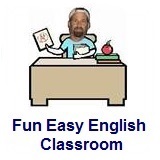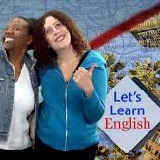|
Additional Lessons |
 About These
Lessons About These
Lessons
The following classroom lessons are great for students
who want additional conversation, listening, and reading
practice. |
-
Conversation Lesson -
Intermediate Level. Let's
Learn English conversation lesson
with a conversation video, a video script, audio
listening practice, and a new
words section.
|
 Conversation Lesson
17 - Flour Baby, Part 1 Conversation Lesson
17 - Flour Baby, Part 1
(Intermediate -
Conversation, Listening, Reading)
In this lesson Ms. Weaver gives Anna and Pete a new
assignment: make a show about single parents. But first,
she wants them to try out parenting for themselves. |
Lesson Video
Watch the video and then read the video script. |
Video Script
Ms. Weaver: Anna, Pete, I have a new assignment for you -- a show on single
parents! What is it like for a mother or a father to raise a child by herself or
himself?
Anna: We can interview single parents. They can share their experiences
themselves.
Ms. Weaver: Yes, but you need to experience parenthood yourselves.
Anna: Ourselves?
Peter: Yeah, how do we do that? We’re not parents.
Ms. Weaver: I asked myself the same question. I said, "Caty, how are they gonna
do that?" Then an idea came to me. I will give you the babies!
Professor Bot: You may be asking yourself the same thing that I’m asking myself:
what is Ms. Weaver talking about!? I am sure we will find out shortly.
This lesson teaches reflexive pronouns.
Reflexive pronouns refer back to the subject of a sentence or clause. We use
them when the subject and the object are the same person or thing.
For example, Ms. Weaver says, “I asked myself the same question.”
“I” is the subject and “myself” refers back to it. Here, she would not use the
pronoun “me.” You need to use the reflexive pronoun “myself.”
Reflexive pronouns are easy to find: they end in “self” or “selves.” I have a
feeling we are going to see a lot of reflexive pronouns. Listen for them!
(Pete and Anna continue their meeting with Ms. Weaver. She puts two bags of
flour on the table. Pete and Anna still look confused.)
Ms. Weaver: Here are your babies!
Pete: Those are bags of flour.
Ms. Weaver: No, Pete, for the next six days, this is your baby. Here are your
instructions. Do not leave your babies alone. A baby cannot take care of itself.
And you two must do everything by yourselves.
We will meet next Friday. Oh, and the person who does the best research will get
an extra day of vacation. Help yourself to a baby.
Anna: Pete, look, my baby is organic and whole grain. Your baby is ordinary.
(Pete pushes her flour baby off desk.)
Anna: (to Pete) Monster! (to Caty) This is a great idea, Ms. Weaver!
(Pete and Anna are now outside.)
Pete: This is a terrible idea.
Anna: Speak for yourself, Pete! We need to throw ourselves into the research!
I’m starting right now!
(She leaves but forgets her Flour Baby.)
Pete: Hey Anna, you forgot your baby!
(She turns and looks at Pete.)
Anna: Come to mama!
(The bag of flour flies at her. She catches it.)
Anna: Good girl! Good girl!
Professor Bot: Singular reflexive pronouns end in “self.” Plural ones end in
“selves.”
Anna says, “We need to throw ourselves into the research!” The subject “we” is
plural. So, we must use the plural reflexive pronoun “ourselves.”
(The parenting research begins. Anna tries to open a baby stroller but can’t. A
man walking by helps her. She pushes Flour Baby in the stroller but it falls
out. On another day, she jogs with it. After several days, she is tired!)
Anna: This is hard! I hope Pete is not doing well. I really need that vacation
day!
Professor Bot: We will all see how Pete is doing in the next episode. We’ll also
learn when not to use reflexive pronouns. |
Listening
Now practice listening to only the audio portion of the conversation. |
|
Practice |
Now, practice the grammar you just learned!
Use the Comments section below to tell us about taking care of a baby (real or
not), or maybe an animal. You can talk about yourself, or maybe a friend or
family member/s. What happened? How did it go?
Using Reflexive Pronouns
We use reflexive pronouns when the subject and object of the sentence or clause
are the same person or thing.
Ex: I asked myself the same question.
Subjects and their reflexive pronouns:
I…myself
You…yourself
He…himself
Her…herself
One…oneself
It…itself
We…ourselves
You…yourselves
They…themselves
A reflexive pronoun can be a direct object, indirect object or an object of the
preposition.
Direct Object:
Ex: A baby cannot take care of itself.
Indirect Object:
Ex: I asked myself the same question.
Object of the Preposition:
Ex: Anna and Pete are experiencing parenthood for themselves.
To show emphasis:
Sometimes, we use reflexive pronouns simply to emphasize the person or thing in
the sentence or clause. In this case, the reflexive pronoun often appears at the
end of the sentence:
Ex: Anna took care of the baby herself.
We do NOT use reflexive pronouns:
After prepositions of place
Ex: Anna found the flour baby in the kitchen herself. (wrong)
Anna found the flour baby in the kitchen. (right)
After these verbs: meet, feel, relax, concentrate
Ex: They will meet themselves at The Studio next Friday. (wrong)
They will meet at The Studio next Friday. (right)
After verbs that describe things we normally do for ourselves, such as dress,
shave and wash
Ex: Anna got dressed herself for a day with her new flour baby. (wrong)
Anna got dressed for a day with her new flour baby. (right)
Don't miss the next episode when we'll talk more about when not to use reflexive
pronouns! |
|
New Words |
- experience –
n. the process of doing and seeing things
and of having things happen to you
- gonna –
informal. In casual conversation, most Americans
change “going to” to “gonna.”
- instructions –
n. statements that describe how to do
something
- ordinary –
adj. normal or usual
- monster –
n. an extremely cruel or evil person
- parenthood –
n. the state of being a mother or father
- refer –
v. to have a direct connection or relationship
to something
- single –
adj. not married or not having a serious
romantic relationship with someone
- speak for yourself -
expression. something you say to
someone to say that the opinion that they have just
expressed is not the same as your opinion
- stroller -
n. a small carriage with four wheels that a
baby or small child can ride in while someone pushes it
- terrible –
adj. very shocking and upsetting
- throw (reflexive pronoun) into –
expression. to begin to
do something with great energy and determination
|
 Conversation
Lessons Conversation
Lessons
Study all 30 English intermediate conversation lessons.
Let's Learn English conversation lessons each with a
conversation video, a video script, audio listening
practice, and a new
words section.
These lessons are for
intermediate students. |
 Conversation
Lessons Conversation
Lessons
Study all 52 English beginner conversation lessons. Let's Learn
English conversation lessons each with a conversation
video, a video script, audio listening practice, video
speaking practice, video pronunciation practice, a new
words section, and a writing activity.
These
lessons are for beginning students. |
|
Source:
Voice of America |
|